Caryn

 My grand niece, Reagan Parmely almost shared her mom’s birthday, but she stalled just long enough to have her birthday the next day. I know how that is. I was supposed to be born on my dad’s birthday, but I stalled two days. It wasn’t our fault. After all, we didn’t know, we were just being born when we were supposed to. Well, all kidding aside, the day Reagan was born changed the lives of her parents, Ashley and Eric Parmely, forever. That was the day they became parents. They were no longer parents-to-be or a couple. They were parents and they had a family. It is the most amazing day in a person’s life. That was 8 years ago, and now Reagan is big sister to three siblings…Hattie, Bowen, and Maeve. Life is good!!
My grand niece, Reagan Parmely almost shared her mom’s birthday, but she stalled just long enough to have her birthday the next day. I know how that is. I was supposed to be born on my dad’s birthday, but I stalled two days. It wasn’t our fault. After all, we didn’t know, we were just being born when we were supposed to. Well, all kidding aside, the day Reagan was born changed the lives of her parents, Ashley and Eric Parmely, forever. That was the day they became parents. They were no longer parents-to-be or a couple. They were parents and they had a family. It is the most amazing day in a person’s life. That was 8 years ago, and now Reagan is big sister to three siblings…Hattie, Bowen, and Maeve. Life is good!!
Reagan has grown up around farm animals, and for most of her life, that was all about the cuddling and chasing of the animals and their babies, but as she grew, she began to understand that sometimes, you are raising your family’s food, and that as such, the food must be killed so it can be eaten. I don’t think that is an easy lesson for anyone, adult or child. I have raised cows too, and I didn’t want to watch on butchering day, but you have to help, and there it is. Reagan understands this, and while she may not like that part, she knows that it puts food of the family table. I am very proud of Reagan’s maturity in these things.
Reagan and especially her sister, Hattie, has become excellent horsewomen. Their brother, Bowen is coming along too. When these kids were little, I found myself feeling amazed at these little kids standing on the ground beside these great horses, and they weren’t afraid at all. Now, these little kids can ride horses like the wind, and they are only getting better and better. When I first saw them on those horses, they looked so…little, and 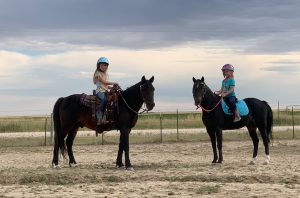
 since I have not grown up around horses, I thought that it looked so dangerous, but these kids, and Reagan first felt right at home. Of course, they have been on these horses since they were just babies riding with their mom, who has also been riding since she was little. These day, with Reagan leading the next generation, the Parmely kids are spending lots of time riding their horses, and really enjoying the outdoors. Today is Reagan’s 8th birthday. Happy birthday Reagan!! Have a great day!! We love you!!
since I have not grown up around horses, I thought that it looked so dangerous, but these kids, and Reagan first felt right at home. Of course, they have been on these horses since they were just babies riding with their mom, who has also been riding since she was little. These day, with Reagan leading the next generation, the Parmely kids are spending lots of time riding their horses, and really enjoying the outdoors. Today is Reagan’s 8th birthday. Happy birthday Reagan!! Have a great day!! We love you!!

 My niece, Ashley Parmely is a very busy girl these days. She has long been a farmer…raising horses, cows, chickens, goats, pigs, dogs, cats, and farmers. There may be others too that I am unaware of. Taking care of all those animals and her four little farmers too, keeps her running all day. Personally, I don’t know where she gets the energy for all of it, and as if that weren’t enough, this year, with the ongoing pandemic, she has taken on a new role…that of teacher to her three little students…all while also keeping her youngest girl, Maeve busy while she teaches the older children, Reagan, Hattie, and Bowen. If she doesn’t know why she might be tired, I say…”Let me enlighten you!!”
My niece, Ashley Parmely is a very busy girl these days. She has long been a farmer…raising horses, cows, chickens, goats, pigs, dogs, cats, and farmers. There may be others too that I am unaware of. Taking care of all those animals and her four little farmers too, keeps her running all day. Personally, I don’t know where she gets the energy for all of it, and as if that weren’t enough, this year, with the ongoing pandemic, she has taken on a new role…that of teacher to her three little students…all while also keeping her youngest girl, Maeve busy while she teaches the older children, Reagan, Hattie, and Bowen. If she doesn’t know why she might be tired, I say…”Let me enlighten you!!”
Being the teacher is a very new concept to Ashley. I don’t think it was a role she had ever imagined herself in. Nevertheless, with the Covid-19 Pandemic, and the hornet’s nest it stirred up in the education system, she and my nephew, Eric Parmely have decided that it is the best way to educate their children. Now as the teacher, you are held to a high educational standard, and it was here that Ashley came across her first stumbling block. No, it wasn’t academically, she’s fine with that. No…it was in penmanship. Not the part about being able to read her writing, but rather, her struggle with “chalkboard writing.” Seriously…how can you aske your students to write in nice straight lines, when you are unable to do so. Hahahahaha!! Ashley is working hard on this problem, and now, a little way into the quarter, I believe she has it under control.
For Ashley, homeschooling the kids is in many ways a dream come true. She has her children at home with her, and they can have relaxed classes on the farm. Homeschooling isn’t a new concept. It has been going on for many years, it’s just that now, with the pandemic, more people have opted for homeschooling. Ashley and Eric 
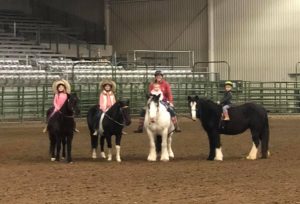 are concerned over some of the new radical education plans for things. Some of the things their kids are learning, really seem extreme to Ashley and to many other Christian and Conservative parents. Kids need time to be kids, and with Ashley, I know that the kids will have just that. Ashley has a wonderful sense of humor and isn’t afraid to look silly sometimes. I believe it will make her the kids favorite teacher. Today is Ashley’s birthday. Happy birthday Ashley!! Have a great day!! We love you!!
are concerned over some of the new radical education plans for things. Some of the things their kids are learning, really seem extreme to Ashley and to many other Christian and Conservative parents. Kids need time to be kids, and with Ashley, I know that the kids will have just that. Ashley has a wonderful sense of humor and isn’t afraid to look silly sometimes. I believe it will make her the kids favorite teacher. Today is Ashley’s birthday. Happy birthday Ashley!! Have a great day!! We love you!!
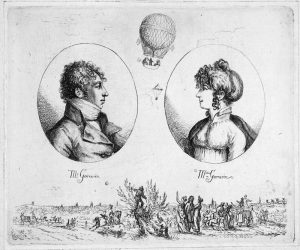 Jumping out of a perfectly good airplane…known by most of us as a parachute jump…is something that the majority of us would probably not do. Still, there are many people that love to jump, and others who would love to try it. I would have thought that this was a rather new hobby, and a even fairly new way to fight fires or fight wars, but I would be wrong. The first parachute jump is said to have taken place in 1797…yes, I said 1797!! How could that be? There weren’t even any planes?
Jumping out of a perfectly good airplane…known by most of us as a parachute jump…is something that the majority of us would probably not do. Still, there are many people that love to jump, and others who would love to try it. I would have thought that this was a rather new hobby, and a even fairly new way to fight fires or fight wars, but I would be wrong. The first parachute jump is said to have taken place in 1797…yes, I said 1797!! How could that be? There weren’t even any planes?
That first parachute jumper was André-Jacques Garnerin from a hydrogen balloon 3,200 feet above Paris. Military jumpers jump at altitudes between 15,000 feet and 35,000 feet…which seems a bit high to me, but what do I know. The lowest altitude to jump is an almost suicidal 100 feet. That put Garnerin’s jump on the low end of the safe spectrum. Garnerin first came up with the idea of using air resistance to slow an individual’s fall from a high altitude while he was a prisoner during the French Revolution. Although he never employed a parachute to escape from the high ramparts of the Hungarian prison where he spent three years, Garnerin never lost interest in the concept of the parachute. He thought that given enough height, he could have escaped from that prison.
After he was released, he continued to experiment with the idea. Then in 1797, he completed his first parachute. The parachute consisted of a canopy 23 feet in diameter, attached to a basket with suspension lines. He was finally ready. On October 22, 1797, Garnerin attached the parachute to a hydrogen balloon and 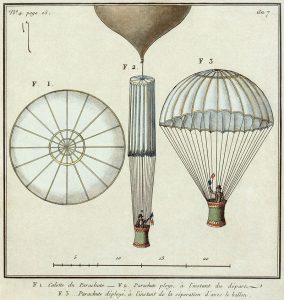 ascended to an altitude of 3,200 feet. He then climbed into the basket and cut the parachute loose from the balloon. To say it was a perfect trial, would be an epic mistake. Garnerin had failed to include an air vent at the top of the prototype, and he oscillated wildly in his descent. Nevertheless, he landed shaken but unhurt half a mile from the balloon’s takeoff site. Unless you are an expert on parachutes, or even an amateur, you probably wouldn’t know about the vent hole. Nevertheless, it is quite important. I would expect that Garnerin’s wife would have been ready to choke him for trying something so crazy, but I would be wrong. In 1799, Garnerin’s wife, Jeanne-Genevieve, became the first female parachutist. I guess he married a woman who was as much an adventurist as he was. They continued on with their work, and in 1802, Garnerin made a spectacular jump from 8,000 feet during an exhibition in England. Unfortunately, he died in a balloon accident on August 18, 1823 while preparing to test a new parachute.
ascended to an altitude of 3,200 feet. He then climbed into the basket and cut the parachute loose from the balloon. To say it was a perfect trial, would be an epic mistake. Garnerin had failed to include an air vent at the top of the prototype, and he oscillated wildly in his descent. Nevertheless, he landed shaken but unhurt half a mile from the balloon’s takeoff site. Unless you are an expert on parachutes, or even an amateur, you probably wouldn’t know about the vent hole. Nevertheless, it is quite important. I would expect that Garnerin’s wife would have been ready to choke him for trying something so crazy, but I would be wrong. In 1799, Garnerin’s wife, Jeanne-Genevieve, became the first female parachutist. I guess he married a woman who was as much an adventurist as he was. They continued on with their work, and in 1802, Garnerin made a spectacular jump from 8,000 feet during an exhibition in England. Unfortunately, he died in a balloon accident on August 18, 1823 while preparing to test a new parachute.
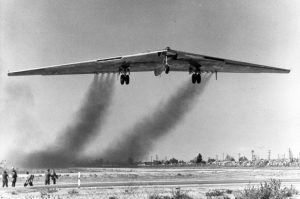 Most airplanes in the 1940s were of a similar design…the kind that were a simple wing design. There was, however, a futuristic flying machine that made it’s debut on October 21, 1947. The Northrup YB-49 Flying Wing was a prototype jet-powered heavy bomber developed by Northrop Corporation shortly after World War II for service with the United States Air Force. The YB-49 featured a futuristic flying wing design and was a turbojet-powered version of the earlier, piston-engined Northrop XB-35 and YB-35. The test flight of the Northrop YB-49 took place at Northrop Field, Hawthorne, California. It was piloted by Chief Test Pilot Max R Stanley. That first flight seemed to be going well, but it faced stability problems during simulated bomb runs and political problems doomed the flying wing.
Most airplanes in the 1940s were of a similar design…the kind that were a simple wing design. There was, however, a futuristic flying machine that made it’s debut on October 21, 1947. The Northrup YB-49 Flying Wing was a prototype jet-powered heavy bomber developed by Northrop Corporation shortly after World War II for service with the United States Air Force. The YB-49 featured a futuristic flying wing design and was a turbojet-powered version of the earlier, piston-engined Northrop XB-35 and YB-35. The test flight of the Northrop YB-49 took place at Northrop Field, Hawthorne, California. It was piloted by Chief Test Pilot Max R Stanley. That first flight seemed to be going well, but it faced stability problems during simulated bomb runs and political problems doomed the flying wing.
The unusual configuration, for an aircraft of that time, had no fuselage or tail control surfaces. The crew compartment, engines, fuel, landing gear, and armament were contained within the wing. Air intakes for the turbojet engines were placed in the leading edge and the exhaust nozzles were at the trailing edge. Four small vertical fins for improved yaw stability were also at the trailing edge. While the design might have had many stabilizing characteristics, it was still basically a set of wings, connected together, with a small crew  compartment in the middle. I suppose it looked like an early version of the F-117 Nighthawk stealth airplane, but with much bigger wings and a much smaller crew cabin.
compartment in the middle. I suppose it looked like an early version of the F-117 Nighthawk stealth airplane, but with much bigger wings and a much smaller crew cabin.
The YB-49 was powered by eight General Electric, Allison Engine Company, J35-A-5 engines. A variant of that engine was used in the North American Aviation XP-86, replacing its original Chevrolet-built J35-C-3. The engines were later upgraded to J35-A-15s. The J35 was a single-spool, axial-flow turbojet engine with an 11-stage compressor and single-stage turbine. It shocks me that there was such a thing as a turbojet engine back then, but apparently there was. During the testing of the YB-49, it reached a maximum speed of 428 knots (493 miles per hour) at 20,800 feet. It had a cruising speed of 365 knots (429 miles per hour). The airplane had a service ceiling of 49,700 feet. The YB-49 had a maximum fuel capacity of 14,542 gallons of JP-1 jet fuel. Its combat radius was 1,403 nautical miles. The maximum bomb load of the YB-49 was 16,000 pounds, though the actual number of bombs was limited by the volume of the bomb bay and the capacity of each bomb type. While the YB-35 Flying Wing was planned for multiple machine gun turrets, but none were attached.
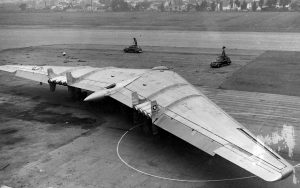 In the second test flight, the unstable YB-49 crashed on Jan. 13, 1948. After the crash, the testing continued with both aircraft until the second YB-49 crashed on June 5, 1948. They tried to make the plane work, but it just didn’t seem to be in the cards. The crew of the crashed YB-49 included Major Daniel H Forbes Jr, pilot; Captain Glen W Edwards, copilot; Lieutenant Edward L Swindell, flight engineer; Clare E Lesser and C C La Fountain. Later, The two pilots were honored with the naming of two Air Force installations. Edwards Air Force Base, California, was named in honor of Captain Edwards, and Forbes Air Force Base, Kansas, was named in honor of Major Forbes.
In the second test flight, the unstable YB-49 crashed on Jan. 13, 1948. After the crash, the testing continued with both aircraft until the second YB-49 crashed on June 5, 1948. They tried to make the plane work, but it just didn’t seem to be in the cards. The crew of the crashed YB-49 included Major Daniel H Forbes Jr, pilot; Captain Glen W Edwards, copilot; Lieutenant Edward L Swindell, flight engineer; Clare E Lesser and C C La Fountain. Later, The two pilots were honored with the naming of two Air Force installations. Edwards Air Force Base, California, was named in honor of Captain Edwards, and Forbes Air Force Base, Kansas, was named in honor of Major Forbes.
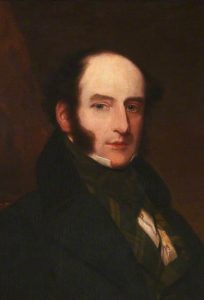 These days, a surgery is performed in comfort, as the patient is under anesthesia, and therefore, feels none of the surgical procedure, at least that is true for most people. There are an unfortunate few for whom anesthesia has little effect. Dr Robert Liston was a pioneering Scottish surgeon, well known for his skills in an era prior to anesthetics, when speed made a difference in terms of pain and survival. For most of us, the idea of a surgery performed in a matter of seconds would not instill much confidence in the doctor…or the procedure, but there was a time when all surgical procedures were performed in this way. People couldn’t take it very long, and the only thing they might have to dull the pain was alcohol…just like we have all seen in the old western movies.
These days, a surgery is performed in comfort, as the patient is under anesthesia, and therefore, feels none of the surgical procedure, at least that is true for most people. There are an unfortunate few for whom anesthesia has little effect. Dr Robert Liston was a pioneering Scottish surgeon, well known for his skills in an era prior to anesthetics, when speed made a difference in terms of pain and survival. For most of us, the idea of a surgery performed in a matter of seconds would not instill much confidence in the doctor…or the procedure, but there was a time when all surgical procedures were performed in this way. People couldn’t take it very long, and the only thing they might have to dull the pain was alcohol…just like we have all seen in the old western movies.
Dr Robert Liston was an expert. He could perform an amputation in seconds. All was going well, and he was a trusted surgeon until 1847, when he was performing an amputation, which he completed in 25 seconds. He was operating so quickly that he accidentally amputated his assistant’s fingers as well. I can only imagine the shock. His was a career filled with skill and excellence, and in an instant, he had a major mistake on his hands.
Dr Liston was famous for his speedy surgeries…often lasting only around 30 seconds. He was well known and respected. In his book “Practical Surgeries,” published in 1837, he emphasizes the importance of quick surgeries, arguing that “these operations must be set about with determination and completed rapidly.” It was all he knew to do. At that time in history, it was the standard of care that everyone expected.
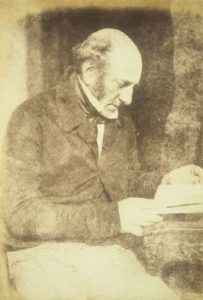
Not everyone believes that the mishap was a true story, and I suppose we will never know, but as the story goes, the case went from bad to worse, when both the patient and the assistant developed sepsis and died. In addition, a spectator reportedly died of shock, meaning that the mortality rate of that one surgery was 300%. While that one surgery was terrible, Dr Liston had many stories of amazing surgeries and miraculous successes. Nevertheless, this one surgery was his most famous. There is a saying by Michael Josephson that goes like this, “We judge ourselves by our best intentions and most noble deeds, but we will be judged by our worst act.” That worst act doesn’t necessarily have to be intentional, and in fact most “worst acts” aren’t intentional. Liston was a good surgeon, and even if he did have this mishap, his overall mortality rate was actually impressive compared to his peers…especially when you consider the speed factor. According to historian Richard Hollingham, “of the 66 patients Liston operated between 1835 and 1840, only 10 died – a death rate of only around 16%.”
 There are among us sometimes, people who are naturally humble. These aren’t beaten down people of no real worth, but rather people of great worth to those around them, but who somehow do their “good deeds” under the radar, and thereby go almost unnoticed. My Uncle Jim Richards is one of those people. His life in service to those around him really began at the very young age of just eight years. At that time, less than a year after losing his older brother Daile during the D-Day attack at Normandy, France, and with 12 remaining siblings, 4 of whom were younger than he was, Uncle Jim realized that his mother was going to need the help of her children to get through all this. Not many 8 year old boys would be able to grasp all that, but Uncle Jim wasn’t a typical 8 year old boy. He was the kind of boy, who saw a need, and went out of his way to meet that need. I suppose there might have been 8 year old boys who would want everyone to know what they had done for their family, but Uncle Jim wasn’t one of those 8 year old boys. He simply saw a need, and went forward to meet the need. That was his nature.
There are among us sometimes, people who are naturally humble. These aren’t beaten down people of no real worth, but rather people of great worth to those around them, but who somehow do their “good deeds” under the radar, and thereby go almost unnoticed. My Uncle Jim Richards is one of those people. His life in service to those around him really began at the very young age of just eight years. At that time, less than a year after losing his older brother Daile during the D-Day attack at Normandy, France, and with 12 remaining siblings, 4 of whom were younger than he was, Uncle Jim realized that his mother was going to need the help of her children to get through all this. Not many 8 year old boys would be able to grasp all that, but Uncle Jim wasn’t a typical 8 year old boy. He was the kind of boy, who saw a need, and went out of his way to meet that need. I suppose there might have been 8 year old boys who would want everyone to know what they had done for their family, but Uncle Jim wasn’t one of those 8 year old boys. He simply saw a need, and went forward to meet the need. That was his nature.
Uncle Jim was a hard worker, who was good at his job, but his first loyalty was always to his family. From boyhood, when he did what things he could to help the family financially, to the later years when a number of his siblings as well as him mom lived with him and his family when they needed to. He also helped out with my grandparents, who were his wife, my Aunt Dixie’s parents, as they got older and needed assistance. And then 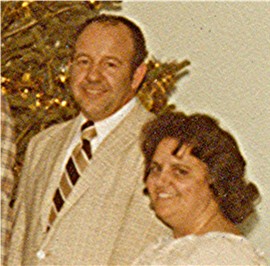 he became the chauffer for his grandchildren when his kids had worked and their kids needed a babysitter and a ride home from school. Of course, he couldn’t always do that, but when he retired, he took great pleasure in the time he spent being the “bus driver” for his grandchildren.
he became the chauffer for his grandchildren when his kids had worked and their kids needed a babysitter and a ride home from school. Of course, he couldn’t always do that, but when he retired, he took great pleasure in the time he spent being the “bus driver” for his grandchildren.
Uncle Jim has always had a quiet demeanor. He isn’t a really chatty person, but when he says something, it is always full of love and kindness. People think of him as a teddy bear type, because of his personality. I have to agree with them, because that is always the way I thought of him…not the teddy bear part, exactly, but when I heard that, I had to agree. Today is Uncle Jim’s 83rd birthday. Happy birthday Uncle Jim!! Have a great day!! We love you!!
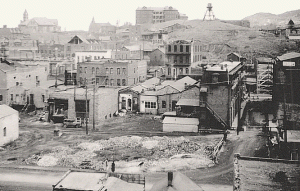 For many years my husband’s Aunt Marian and Uncle John Kanta lived in Helena, Montana. Some of their kids still do, but they didn’t live there in 1935, when on October 18th, a magnitude 6.2 earthquake struck at 10:48pm. The quake had its epicenter right near Helena and it had a maximum perceived intensity of VIII (Severe) on the Mercalli intensity scale. The quake on that date was the largest of a series of earthquakes that also included a large aftershock on October 31 of magnitude 6.0 and a maximum intensity of VIII. Two people died in the first quake, and two others died as a result of the October 31 aftershock. Property damage was over $4 million.
For many years my husband’s Aunt Marian and Uncle John Kanta lived in Helena, Montana. Some of their kids still do, but they didn’t live there in 1935, when on October 18th, a magnitude 6.2 earthquake struck at 10:48pm. The quake had its epicenter right near Helena and it had a maximum perceived intensity of VIII (Severe) on the Mercalli intensity scale. The quake on that date was the largest of a series of earthquakes that also included a large aftershock on October 31 of magnitude 6.0 and a maximum intensity of VIII. Two people died in the first quake, and two others died as a result of the October 31 aftershock. Property damage was over $4 million.
Helena is a pretty city that lies in a valley in western Montana. It lies within the northern part of the Intermountain Seismic Belt (ISB). I didn’t know it then, but this is an area of relatively intense seismicity. It runs from northwestern Arizona, through Utah, Idaho, and Wyoming, before dying out in northwestern Montana. In the area near Helena, it turns to the northwest, where it intersects with the Lewis and Clark fault zone. The Helena earthquake sequence actually began October 3, 1935, with a small earthquake. That quake was followed by a damaging earthquake on October 12th, a magnitude 5.9, intensity VII. That wasn’t the mainshock, however. That one occurred on October 18th, a magnitude 6.2, intensity VIII. A lesser shock followed on October 31st, a magnitude 6.0, intensity VIII, and a further large aftershock on November 28th, a magnitude 5.5, intensity VI. These were just the mainshocks. There were also a total of 1800 tremors recorded 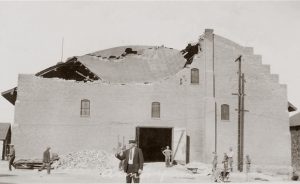 between October 4, 1935 and April 30, 1936. The people of Helena either got used to the shaking, which I can’t imagine, or they were terrified with every tremor, which makes more sense to me.
between October 4, 1935 and April 30, 1936. The people of Helena either got used to the shaking, which I can’t imagine, or they were terrified with every tremor, which makes more sense to me.
The damage to the unreinforced buildings of that era was widespread, with more than 200 chimneys destroyed in the city of Helena. At that time, little was known about reinforcement of buildings in earthquake prone areas. The northeast part of the city, where buildings were constructed on alluvial soil, and in the southern business district, which contained many brick buildings, saw the strongest effects. Alluvial soil is highly porous, which would explain the soil liquification that took place. The most extensively damaged building was the Helena High School, which was completed in August 1935 and had just been dedicated in early October. The school buildings, which had cost $500,000, had not been designed to be earthquake resistant. Another building that was totally destroyed and had to be rebuilt was the Lewis and Clark County Hospital. The October 18 earthquake caused an estimated $3 million of damage to property. The aftershock of October 31 caused further damage estimated at $1 million, particularly to structures already weakened by the October 18 shock. Two people were killed by falling bricks in Helena during the October 18 shock. Two brick masons died as while removing a brick tower during the October 31 aftershock.
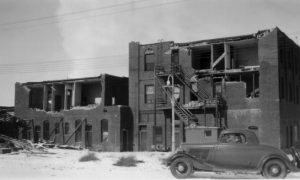 The Red Cross and Federal Emergency Relief Administration set up emergency camps for those displaced by the quake on land at the Montana Army National Guard’s Camp Cooney. Approximately 400 people stayed there the first night, but most had found space with friends or family outside of the damaged area by the end of the week. Some people were too afraid of continued shocks to stay in a house, and they stayed in tents for the next few weeks. The National Guard was deployed in Helena to keep sightseers away from the damaged buildings, and either because of the guard or the good moral values of the people, there was no looting. It is believed that in today’s world, the damages would have been in the $500 million range.
The Red Cross and Federal Emergency Relief Administration set up emergency camps for those displaced by the quake on land at the Montana Army National Guard’s Camp Cooney. Approximately 400 people stayed there the first night, but most had found space with friends or family outside of the damaged area by the end of the week. Some people were too afraid of continued shocks to stay in a house, and they stayed in tents for the next few weeks. The National Guard was deployed in Helena to keep sightseers away from the damaged buildings, and either because of the guard or the good moral values of the people, there was no looting. It is believed that in today’s world, the damages would have been in the $500 million range.
 Prisoners have tried to escape ever since there have been prisons. It is the nature of the situation. No one likes to be locked up. Most escape attempts are not successful, and few are what we would consider well planned, but in the case of Florida prison inmates, Charles Walker and Joseph Jenkins, some kind of good planning must have gone into the escape plan. The two men were serving life sentences, without the possibility of parole, for murder, and so I guess they had nothing to lose by getting caught in an escape attempt. Jenkins was incarcerated for a 1998 murder and armed robbery and a 1997 auto theft. He has been in prison since 2000. Walker was imprisoned for a 1999 murder and has been in custody since 2001.
Prisoners have tried to escape ever since there have been prisons. It is the nature of the situation. No one likes to be locked up. Most escape attempts are not successful, and few are what we would consider well planned, but in the case of Florida prison inmates, Charles Walker and Joseph Jenkins, some kind of good planning must have gone into the escape plan. The two men were serving life sentences, without the possibility of parole, for murder, and so I guess they had nothing to lose by getting caught in an escape attempt. Jenkins was incarcerated for a 1998 murder and armed robbery and a 1997 auto theft. He has been in prison since 2000. Walker was imprisoned for a 1999 murder and has been in custody since 2001.
The men were serving their time in a Panhandle prison called Franklin Correctional Institution in Carrabelle, Florida. accidentally released two inmates from a Panhandle prison who are convicted murderers, according to published reports. Somehow, Walker and Jenkins, both 34, were able to obtain fraudulent orders of sentence modification. Based on those modifications, Jenkins was released on September 27, 2013, and Walker was released on October 8, 2013. Both were former residents of Orlando. Their release was apparently “in accordance with Department of Corrections policy and procedure. However, both of their releases were based on fraudulent modifications that had been made to court orders,” Department of Corrections secretary Michael Crews said.
The judge whose name is on the forged documents is Belvin Perry, Orange County chief judge, who presided  over the Casey Anthony case. Perry’s office said that the judge’s signature was forged in the paperwork calling for reduced sentences for the convicted killers. Apparently, however, while the false documents had problems the one thing that was correct was the judges signature. The judge denies any wrongdoing, saying “It is quite evident that someone forged a court document, filed a motion, and that someone with the aid of a computer, lifted my signature off previous signed documents, which are public reports, affixed that to the document, sent it to the clerk’s office. It was processed and forwarded to doc and the defendant ended up being released,” Perry maintains. He also says, “I have never seen anything like this. You have to give them an A for being imaginative and effective.” The reality is that this was not the first time a prisoner managed to obtain false documents, and probably wont be the last, since no one was caught in this act. The prison waited 17 days before notifying the authorities of the escape. Cybercrime is the newest thing. Easy to perform, hard to catch.
over the Casey Anthony case. Perry’s office said that the judge’s signature was forged in the paperwork calling for reduced sentences for the convicted killers. Apparently, however, while the false documents had problems the one thing that was correct was the judges signature. The judge denies any wrongdoing, saying “It is quite evident that someone forged a court document, filed a motion, and that someone with the aid of a computer, lifted my signature off previous signed documents, which are public reports, affixed that to the document, sent it to the clerk’s office. It was processed and forwarded to doc and the defendant ended up being released,” Perry maintains. He also says, “I have never seen anything like this. You have to give them an A for being imaginative and effective.” The reality is that this was not the first time a prisoner managed to obtain false documents, and probably wont be the last, since no one was caught in this act. The prison waited 17 days before notifying the authorities of the escape. Cybercrime is the newest thing. Easy to perform, hard to catch.
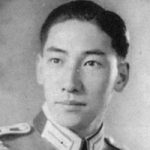 Yang Kyoungjong was a Korean man with an incredible story. In 1938, when he was 18 years old, Kyoungjong was in Manchuria when he was forced into the Kwantung Army of the Imperial Japanese Army to fight against the Soviet Union. It was the outbreak of World War II, and I suppose the Japanese decided they would be better off to make him soldier than to let him languish in a prisoner of war camp. So, fight he did. Korea was ruled by Japan at that time, and Kyoungjong really had no choice to to follow orders.
Yang Kyoungjong was a Korean man with an incredible story. In 1938, when he was 18 years old, Kyoungjong was in Manchuria when he was forced into the Kwantung Army of the Imperial Japanese Army to fight against the Soviet Union. It was the outbreak of World War II, and I suppose the Japanese decided they would be better off to make him soldier than to let him languish in a prisoner of war camp. So, fight he did. Korea was ruled by Japan at that time, and Kyoungjong really had no choice to to follow orders.
During the Battle of Khalkhin Gol, things weren’t going well for the Japanese army, and Kyoungjong was again captured…this time by the Soviet Red Army. He was sent to a Gulag labor camp. While he was there, and with Soviet manpower shortages being what they were, Kyoungjong was presses into service in the Soviet army in 1942. He, along with thousands of other prisoners, were told to fight with the Red Army against Nazi Germany. He was sent to the Eastern Front of Europe.
Somehow, Kyoungjong managed to always be in the wrong place at the wrong time. In 1943, he was once again captured, this time by the Wehrmacht soldiers in eastern Ukraine during the Third Battle of Kharkov. He 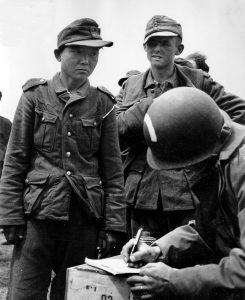 was pressed into service again, and told that he had joined the “Eastern Battalions” to fight for Germany. Kyoungjong was sent to Occupied France to serve in a battalion of former Soviet prisoners of war on the Cotentin peninsula in Normandy, close to Utah Beach. I’m sure he wondered which army he was really a part of.
was pressed into service again, and told that he had joined the “Eastern Battalions” to fight for Germany. Kyoungjong was sent to Occupied France to serve in a battalion of former Soviet prisoners of war on the Cotentin peninsula in Normandy, close to Utah Beach. I’m sure he wondered which army he was really a part of.
During the D-Day landings in northern France by the Allied forces, Kyoungjong was captured by paratroopers of the United States Army in June 1944. The American Army thought he was a Japanese soldier in German uniform at first. At the time, Lieutenant Robert Brewer of the 506th Parachute Infantry Regiment, 101st Airborne Division, reported that his regiment had “captured four Asians in German uniform after the Utah Beach landings, and that initially no one was able to communicate with them.” The good news for Kyoungjong was that he was not going to again be expected to fight with a different army. He was first sent to a prison camp in Britain and later transferred to a camp in the United States.
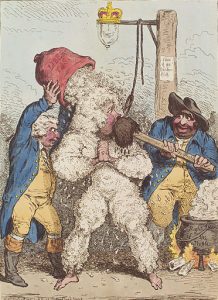 I think most of us have heard of being “tarred and feathered,” as a form of punishment, but we may not really know how much of a punishment it really was. When we think about it, the show, “Home Alone” might come to mind. Of course, some kind of syrup and then the feathers, but that does not really even begin to describe the real act of tarring and feathering.
I think most of us have heard of being “tarred and feathered,” as a form of punishment, but we may not really know how much of a punishment it really was. When we think about it, the show, “Home Alone” might come to mind. Of course, some kind of syrup and then the feathers, but that does not really even begin to describe the real act of tarring and feathering.
In 1776 in Norfolk, Virginia, Captain William Smith was tarred and feathered by a mob which actually included the mayor of Norfolk apparently!! Mobs are never a good thing. They are always out of control, and people who might normally be pretty decent, are dragged into things they might never do otherwise. Captain Smith was suspected of sharing secrets about a local ship owner John Gilcrest smuggling goods, with British officials. It was a terrible offence, but remember that he was “suspected” of this, not convicted. That is the problem with the mobs. They often take matters into their own hands…Vigilante Justice…whether the person is really guilty or not.
Tar and Feather was a medieval form of torture and humiliation. It involved stripping the victim up to his waist, applying tar on his body, and covering him with feathers. That wasn’t the end of it though. The victim was then put on a cart and paraded around the place. Sometimes, the tar was simply poured on the victim’s body and he was made to roll on feathers. This isn’t like syrup or the asphalt tar of today. The tar they used was likely from the pine tar the Colonies were accustomed to distilling for its use on preserving the wood of ships from rot. Hot asphalt tar would critically burn the body. Pine creates charcoal and pine tar when heated up. This pine tar is naturally a sticky substance making it a perfect material for applying to someone who is about to be covered in 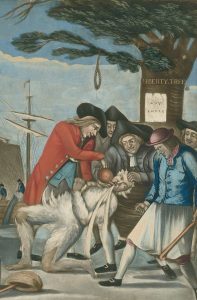 feathers. While that explains why there were no casualties of this form of punishment. Nevertheless, the job of removing the dried pine tar and feathers off the skin was extremely painful.
feathers. While that explains why there were no casualties of this form of punishment. Nevertheless, the job of removing the dried pine tar and feathers off the skin was extremely painful.
After Captain Smith was humiliated by the application of his feathery outfit, he was thrown into the harbor. He almost drowned before being rescued by a passing ship, just as his strength was giving out. He survived, and was later quoted as saying that “…[they] dawbed my body and face all over with tar and afterwards threw feathers on me.” As with most other tar and feathers victims in the decade that followed, Smith was suspected of informing on smugglers to the British Customs service. The punishment was harsh, and it was swift. The colonies were trying to gain their freedom, and that meant that they would fight to the death, and they would never tolerate traitors. I don’t know if Captain Smith was a traitor or not, but no one was ever punished for what they did to him, so there is that.

